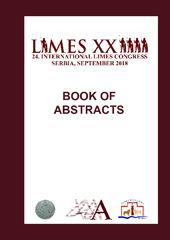Приказ основних података о документу
Recent discovery of sarcophagus in Viminacium. Evidence of mors immatura?
| dc.creator | Danković, Ilija | |
| dc.creator | Mikić, Ilija | |
| dc.date.accessioned | 2024-01-03T14:46:10Z | |
| dc.date.available | 2024-01-03T14:46:10Z | |
| dc.date.issued | 2018 | |
| dc.identifier.isbn | 979-86-6439-039-2 | |
| dc.identifier.uri | http://rai.ai.ac.rs/handle/123456789/1289 | |
| dc.description.abstract | The deaths of young individuals is usually perceived as a failure on behalf of the parents, and of society in general. It is regarded that death of a member of these social groups is premature, that it came before they have reached their full potential or before they fulfilled goals expected of them during their life. In various cultures, burials of such individuals differ from the norm, and it can be expected that they should be recognizable in the archaeological record. One of the categories of this so-called mors immatura consists of young women eligible for marriage who died before having the chance to actually get married, with the subcategory of ones who did accomplish that goal but died before giving birth to any offspring. The emotions of relatives of the deceased were often translated into material culture through rich grave furnishings and choice of specific objects, which was the case in the Mediterranean basin in the Roman period. “Exceptionally lavish” graves of young women were identified in recent scholarly articles as the resting places of young women and girls who were denied marriage or childbirth. The latest excavations in Viminacium resulted in the discovery of an intact sarcophagus. In it were the remains of two individuals, probably members of the family that owned the nearby villa rustica. Preliminary bioarchaeological reports showed that one of the skeletons belonged to a female in her early twenties, while the other individual was male over 45 years of age. Gold and silver objects placed with the woman, as well as hairpins made of jet, could lead to the conclusion that she died before getting married, or at least before bearing children to whom she could bequeath the jewelry. Possible scenarios will be explained through the means of material culture studies and life course theory, and various scientific methods will be employed in order to test the hypotheses presented. | sr |
| dc.language.iso | en | sr |
| dc.publisher | Belgrade : Institute of Archaelogy | sr |
| dc.relation | info:eu-repo/grantAgreement/MESTD/Integrated and Interdisciplinary Research (IIR or III)/47018/RS// | sr |
| dc.rights | openAccess | sr |
| dc.source | 24. Limes Congress. Serbia, 02-09 September 2018, Belgrade-Viminacium. Book of abstracts | sr |
| dc.subject | Viminacium | sr |
| dc.subject | sarcophagus | sr |
| dc.subject | Mors immatura | sr |
| dc.title | Recent discovery of sarcophagus in Viminacium. Evidence of mors immatura? | sr |
| dc.type | conferenceObject | sr |
| dc.rights.license | ARR | sr |
| dc.identifier.fulltext | http://rai.ai.ac.rs/bitstream/id/2192/Limes-Congres-2018-Book-of-abstracts-FINAL-UPDATED.pdf | |
| dc.identifier.rcub | https://hdl.handle.net/21.15107/rcub_rai_1289 | |
| dc.type.version | publishedVersion | sr |


